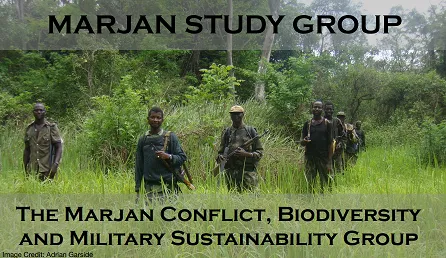What is war? Ancient Roman philosopher, Lucretius, in De Rerum Natura (‘The Nature of Things’) was clear about its identity: it was when humans were at war ‘with Nature’. Today, Lucretius’s ‘Nature’ would be defined as ‘biodiversity’.
The destruction of biodiversity ventilates the connection between conflict, insecure environments and sustainability in the following ways:
- Illegal extraction of fauna, flora and timber
- Land grabbing: habitat destruction, food insecurity
- Illegal mining: commodities from sand and cobalt to oil and minerals
- Water: over-extraction and distribution inequality
- Pollution: fish-stock and marine depletion, air-quality
- Fossil fuels: resource wars, climate-change conflict multiplier
- Bio-security: pandemics and diseases
- ‘Real-time’ insecure environments and conflict environmental destruction
- Post-conflict environmental impacts
All these elements interact with each other at various levels, with climate-change multiplying their vulnerability to overall significantly reduce human security.
With mounting global concern about the impacts of biodiversity loss and environmental effects, armed forces globally will come under greater scrutiny for their engagement with the ‘green space’ in society; for example, the carbon foot-print of the EU military 2019 was the equivalent of 14 million average cars while the UK military comparison was broadly half that figure.
While armed forces in the developed world have highlighted their concerns about the impact of climate change on operational capabilities as well as the generation of ‘non conventional’ threats and reducing their carbon foot-print these also have to be balanced against operational capability.
Furthermore, as military capability is increasingly used to help with natural disasters, pandemic relief and other humanitarian efforts, this raises questions about using the military to assist with civilian emergencies as well as the need for civilian defence forces along with international cooperation for human security.
The Start
The Marjan Centre was formed in 2010 and has steadily developed an inter-disciplinary approach both within King’s College as well as with other academic institutions and outside organisations.
Research
The Marjan Centre’s research programme is designed as a ‘hub’ with transferable material; the two current main projects are (1): Examination of Strategic Wildlife Protection and Involvement Of military forces (SWIPRO); (2): The GreenHelmet Observatory: examination of the many aspects of the relationship between the armed forces and ‘green’ sustainability.
Outreach
The Marjan Centre is committed to distributing its work as wide as possible through education, collaboration and meeting the general public to raise awareness of both the impact and relationship between conflict and the environment; this engagement includes the Marjan Marsh Award given annually to conservationists working in conflict areas (please see ‘Awards’ for full list).
The Marjan Centre is named after a lion named ‘Marjan’, who survived Afghanistan’s violence while living inside Kabul Zoo between 1978-2002 before dying of old age; having lived through vast social upheaval and fighting, ‘Marjan’ the lion has become an icon in both Afghanistan and globally in the representation of both conflict and biodiversity - here is a YouTube link
Our Partners





